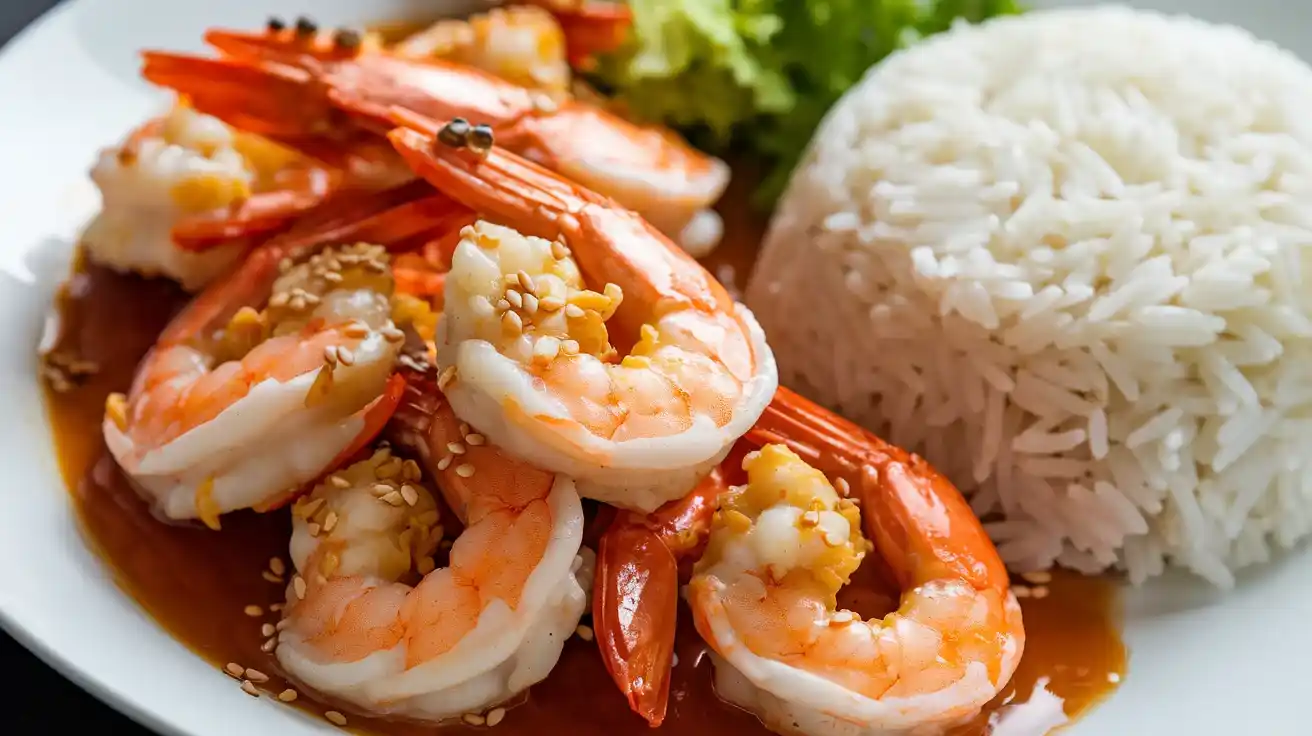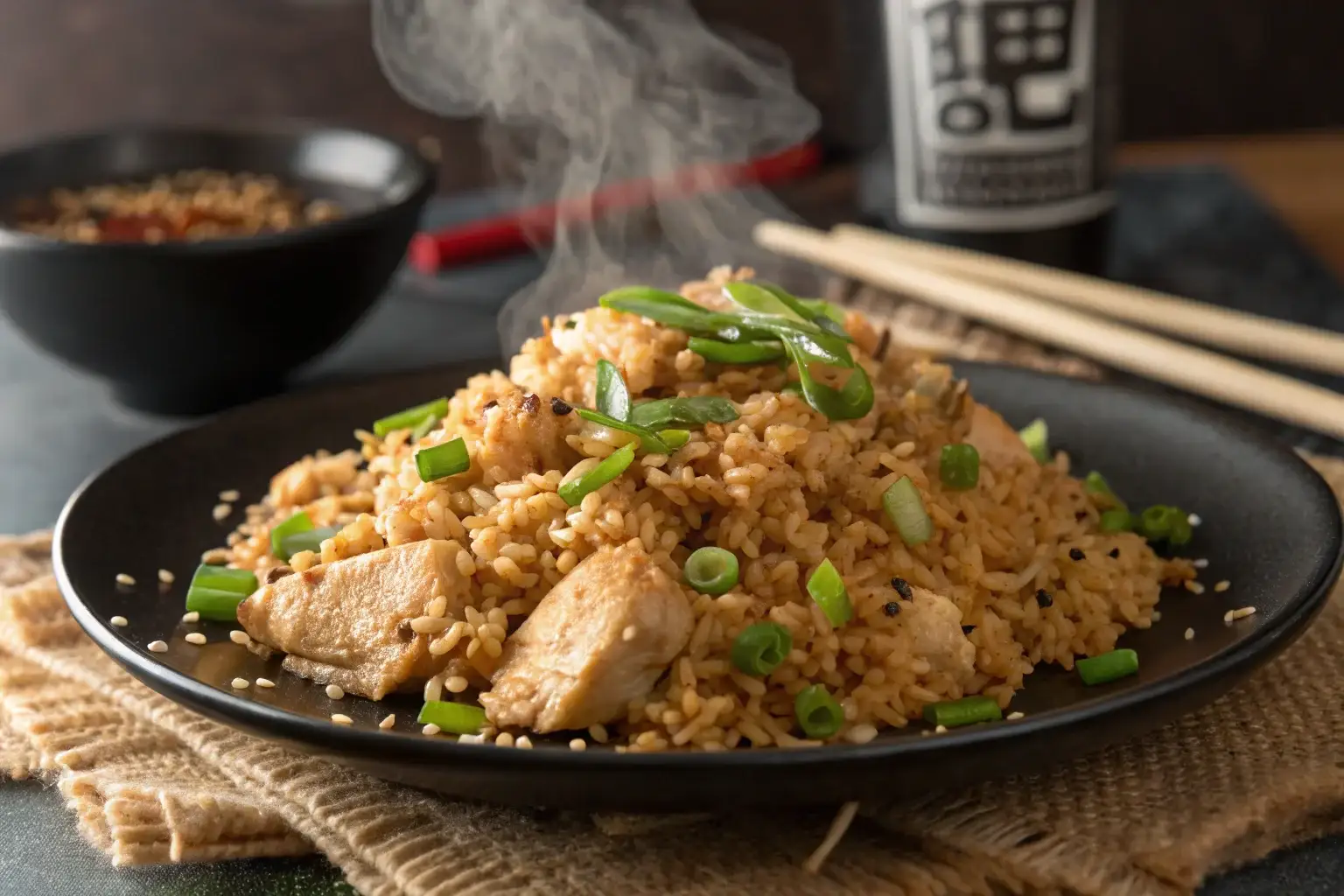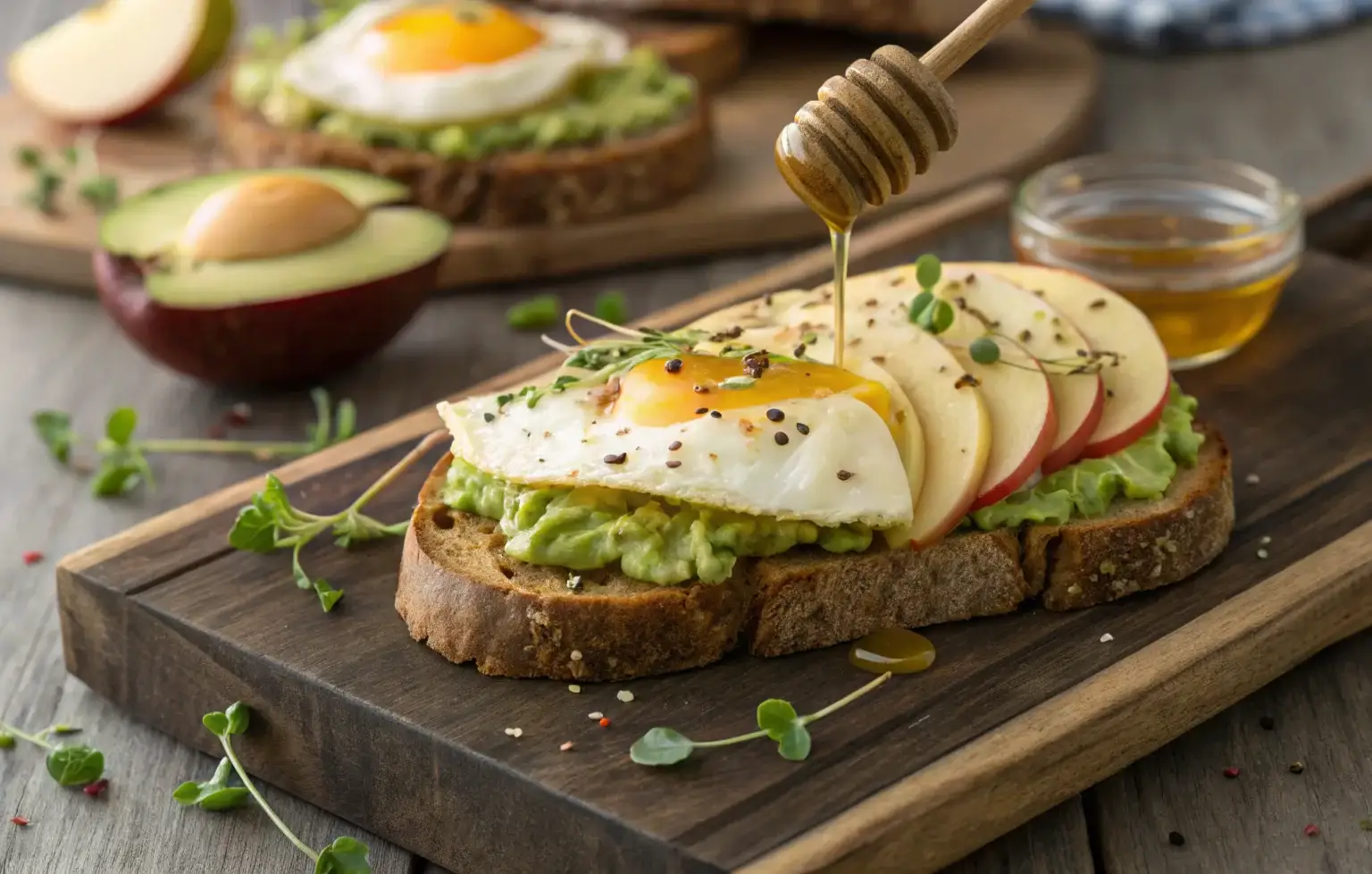sweet and sour shrimp recipe is a classic dish that combines the tangy punch of a perfectly balanced sauce with the delicate juiciness of shrimp. Over the years, I’ve experimented with countless recipes to get that authentic flavor—bouncy shrimp, rich sauce, and the right balance of sweet and tangy. Whether you’re a home cook or a seafood enthusiast, this guide will take you step by step to mastering the ultimate sweet and sour shrimp recipe. Trust me, once you try it, you’ll be hooked!
Looking for other delicious recipes? Check out this creamy corn chowder recipe for another comforting meal.
What Makes sweet and sour shrimp recipe Special?
Origins of Sweet and Sour Shrimp
sweet and sour shrimp recipe has its roots in Chinese cuisine, specifically in Cantonese cooking, where the harmony of flavors reigns supreme. This dish showcases a perfect balance of contrasting tastes—sweetness from sugar or honey, and tanginess from vinegar or citrus. Over time, this dish spread globally, adapting to local tastes but retaining its essence.
Why sweet and sour shrimp recipe is Popular Across Cultures
From bustling Chinese street markets to cozy American kitchens, this dish has become a favorite for its versatility. It caters to all palates, pairing well with rice, noodles, or even steamed vegetables. The combination of tender shrimp and a bold, flavorful sauce ensures it’s always a crowd-pleaser.
The Perfect Dinner Option
Whether you’re preparing a family dinner or entertaining guests, sweet and sour shrimp recipe is an excellent choice. It’s quick to cook, easy to customize, and appeals to everyone—from seafood lovers to those who enjoy bold flavors.
Essential Ingredients for sweet and sour shrimp recipe
Shrimp: Fresh vs. Frozen
When it comes to sweet and sour shrimp, the quality of shrimp can make or break the dish. Fresh shrimp are ideal for their tender texture and naturally sweet flavor. Look for shrimp that are firm, smell fresh, and have a translucent appearance. However, if fresh shrimp aren’t available, frozen shrimp can work just as well. Make sure to defrost them properly by placing them in the fridge overnight or rinsing them under cold water before use.
Sweet and Sour Sauce: Key Elements

The sauce is the heart of this dish. It combines sweetness from sugar or honey and tanginess from vinegar or citrus juice. To create the best sauce, you’ll need these essential ingredients:
- Ketchup: Adds a rich tomato base and vibrant color.
- Vinegar: Provides the tangy punch, with white vinegar or rice vinegar being great options.
- Soy Sauce: Adds depth and a savory umami flavor.
- Sugar or Honey: Balances the acidity with just the right amount of sweetness.
- Cornstarch: Thickens the sauce to coat the shrimp perfectly.
Common Substitutes (Including Pineapple Alternatives)
Pineapple is a staple ingredient in many sweet and sour recipes, adding both flavor and texture. But if you’re out of pineapple or need a substitute, here are some great options:
- Mango Chunks: For a tropical twist with natural sweetness.
- Peach Slices: Adds a mildly sweet flavor without overpowering.
- Apple Cider: Can replace pineapple juice in the sauce.
- Lemon or Lime Juice: Enhances tanginess if sweetness isn’t needed.
Vegetables and Add-Ins
sweet and sour shrimp recipe is often paired with colorful vegetables. Bell peppers (red, yellow, or green), onions, and carrots not only enhance the dish visually but also add a crunchy texture that complements the tender shrimp.
Choosing the Right Oil
For authentic flavor, use neutral oils like vegetable or peanut oil. These oils have a high smoke point, ensuring the shrimp cooks evenly without overpowering the dish.
Preparing the Shrimp for Cooking
Why Do You Soak Shrimp in Milk Before Frying?
Soaking shrimp in milk is a tried-and-true method for achieving tender, juicy shrimp. The milk helps neutralize any fishy odors while breaking down proteins slightly, making the shrimp softer and easier to cook. This simple trick also ensures the shrimp absorbs flavors better when fried or cooked in a sauce. For the best results, soak the shrimp in milk for about 10–15 minutes, then rinse and pat them dry with a paper towel before seasoning.
Cleaning and Deveining Tips
Properly cleaning and deveining shrimp is an essential step before cooking. Here’s how to do it efficiently:
- Remove the Shell: Peel off the shell, leaving the tail intact if desired for presentation.
- Devein the Shrimp: Use a small knife to make a shallow slit along the back of the shrimp. Gently lift out the black vein with the tip of the knife or a toothpick.
- Rinse and Pat Dry: Rinse the shrimp under cold water and pat them dry to remove excess moisture. This ensures they cook evenly and get a nice sear.
How to Make Shrimp Bouncy Like Chinese Food
The secret to achieving that signature bouncy texture in shrimp, common in Chinese dishes, lies in the preparation technique called “velveting.” Follow these steps:
- Coat with Baking Soda: Toss the shrimp with a small amount of baking soda and let them rest for 20–30 minutes. This alters the shrimp’s pH level, giving them a firm yet bouncy texture.
- Rinse Thoroughly: Wash off the baking soda completely to avoid any lingering taste.
- Velvet with Cornstarch: Before cooking, coat the shrimp lightly with cornstarch. This forms a protective layer, keeping the shrimp juicy while locking in flavors.
Making the Perfect Sweet and Sour Sauce
Balancing Sweet and Tangy Flavors
The hallmark of a great sweet and sour sauce is the balance of sweetness and tanginess. Striking this balance ensures the sauce complements the shrimp rather than overpowering it. Here’s how to achieve perfection:
- Sweetness: Use sugar, honey, or even fruit juices like pineapple or orange. These provide the base sweetness of the dish.
- Tanginess: White vinegar, rice vinegar, or apple cider vinegar bring the tartness. Adjust the amount based on your taste preference.
- Umami Depth: Soy sauce adds a layer of complexity that ties the sweetness and tanginess together.
Pro Tip: Always taste as you go! A little adjustment here and there can make a world of difference.
Common Sauce Mistakes to Avoid
- Over-Thickening: Adding too much cornstarch can make the sauce gloopy. Stick to 1–2 teaspoons mixed with water for a smooth consistency.
- Over-Sweetening: Too much sugar can make the sauce cloying. Balance it with vinegar or a splash of citrus juice.
- Lack of Heat: While optional, a small pinch of red chili flakes or sriracha can enhance the flavors without making it overly spicy.
Using Pineapple Substitutes Without Compromising Flavor
If you don’t have pineapple on hand, don’t worry! You can still create an amazing sweet and sour sauce:
- Apple Juice or Cider: Adds a mild sweetness and a slightly fruity note.
- Mango Puree: Offers a tropical twist while maintaining the sweetness.
- Lemon Juice and Sugar Combo: This provides the tangy-sweet effect similar to pineapple.
Step-by-Step Sauce Recipe
- Mix the Ingredients: In a bowl, combine ¼ cup ketchup, ¼ cup vinegar, 2 tablespoons soy sauce, ¼ cup sugar, and ½ cup pineapple juice (or substitute). Stir until smooth.
- Thicken the Sauce: In a separate bowl, mix 1–2 teaspoons of cornstarch with 2 tablespoons of water to create a slurry.
- Cook the Sauce: Heat the mixture in a pan on medium heat, stirring until it thickens and becomes glossy.
Cooking Techniques for Juicy Shrimp
How to Make the Most Tender Shrimp
Cooking shrimp to perfection can be tricky, but a few tips can make all the difference:
- Marinate Carefully: A simple marinade of soy sauce, garlic, and a splash of sesame oil enhances flavor while keeping the shrimp tender. Avoid acidic marinades for too long, as they can “cook” the shrimp, leaving them rubbery.
- Control the Heat: Shrimp cook quickly, so medium-high heat is ideal. Searing locks in moisture, while overcooking makes them tough.
- Know When They’re Done: Shrimp are cooked when they turn pink and curl into a “C” shape. If they curl into an “O,” they’re overcooked!
Secrets to Juicy Shrimp
The secret to juicy shrimp lies in timing and preparation:
- Dry the Shrimp Before Cooking: Patting the shrimp dry with a paper towel ensures they don’t steam in the pan.
- Quick Stir-Fry: Cooking shrimp for 2–3 minutes per side is usually enough.
- Cook in Batches: Overcrowding the pan lowers the temperature, causing uneven cooking. Cook in small batches to get a good sear.
The Importance of Timing in Cooking Shrimp
Timing is critical when cooking shrimp, especially when combining them with sauces and vegetables. Here’s a foolproof plan:
- Cook Shrimp First: Sear or stir-fry the shrimp separately for 2–3 minutes. Remove them from the pan and set aside.
- Prepare the Sauce and Vegetables: Cook your vegetables and sweet and sour sauce in the same pan. This allows the flavors to develop without overcooking the shrimp.
- Combine at the End: Add the cooked shrimp back into the pan with the sauce and veggies. Toss everything together just before serving to keep the shrimp juicy.
Avoiding Overcooking
Shrimp are delicate and can quickly become rubbery if left on the heat too long. A great trick is to remove them from heat just as they turn pink, letting the residual heat finish cooking them.
Step-by-Step Sweet and Sour Shrimp Recipe
Ingredients List and Preparation
To make the best sweet and sour shrimp, gather these simple ingredients:
For the Shrimp:
- 1 lb large shrimp (peeled and deveined)
- 2 tablespoons cornstarch
- ½ teaspoon salt
- ½ teaspoon black pepper
- 2 tablespoons vegetable oil
For the Sweet and Sour Sauce:
- ¼ cup ketchup
- ¼ cup vinegar (white or rice vinegar)
- 2 tablespoons soy sauce
- ¼ cup sugar or honey
- ½ cup pineapple juice (or substitute like apple juice or mango puree)
- 1 teaspoon cornstarch (mixed with 2 tablespoons water for a slurry)
Optional Vegetables and Add-Ins:
- 1 red bell pepper (chopped)
- 1 green bell pepper (chopped)
- 1 medium onion (chopped)
- 1 cup pineapple chunks (optional)
Cooking Instructions for the Shrimp
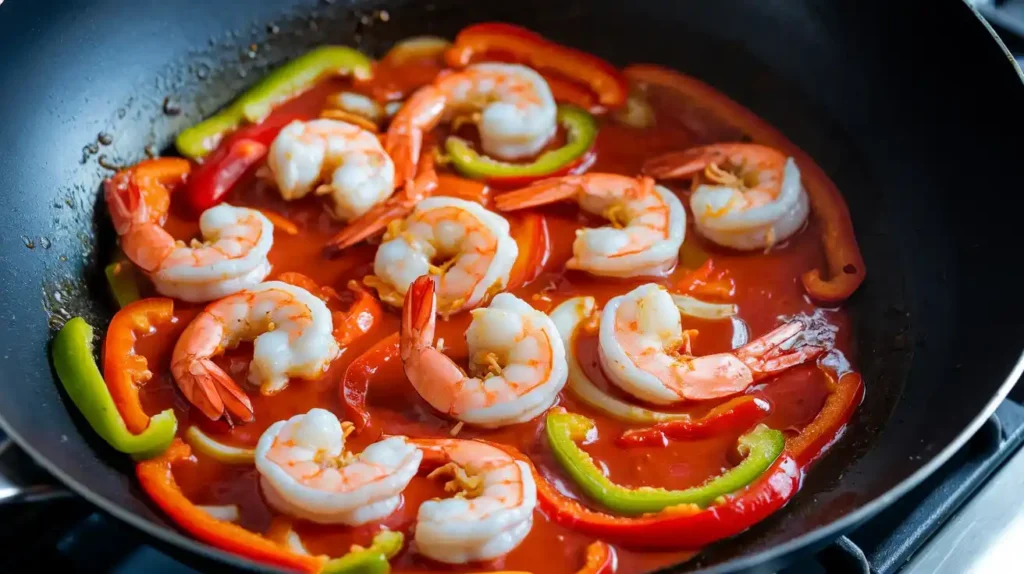
- Prepare the Shrimp: Pat the peeled and deveined shrimp dry with a paper towel. Toss them in a bowl with cornstarch, salt, and pepper. This light coating helps the shrimp stay juicy while adding a slight crispness.
- Sear the Shrimp: Heat 1 tablespoon of vegetable oil in a large wok or skillet over medium-high heat. Add the shrimp in a single layer and cook for about 2 minutes per side until pink and slightly crispy. Remove the shrimp and set aside.
Making the Sweet and Sour Sauce
- Mix the Sauce Ingredients: In a small bowl, whisk together the ketchup, vinegar, soy sauce, sugar, and pineapple juice until well combined.
- Thicken the Sauce: In the same wok or skillet, pour the sauce mixture and bring it to a simmer. Stir in the cornstarch slurry and cook for 2–3 minutes, stirring frequently, until the sauce thickens and becomes glossy.
Cooking the Vegetables and Combining Everything
- Cook the Vegetables: In the same pan, add the remaining tablespoon of oil. Stir-fry the bell peppers, onion, and pineapple chunks (if using) for 2–3 minutes until slightly tender but still crisp.
- Combine Shrimp and Sauce: Add the cooked shrimp back into the pan and pour the thickened sweet and sour sauce over everything. Toss until the shrimp and vegetables are evenly coated in the sauce.
Finishing Touches and Serving
- Garnish: Sprinkle sesame seeds or chopped green onions on top for an extra pop of flavor and texture.
- Serve Hot: Plate the sweet and sour shrimp recipe with steamed jasmine rice or fried rice for a complete meal.
Side Dishes That Complement sweet and sour shrimp recipe
Best Rice Pairings: Jasmine, Fried Rice, or White Rice
Rice is the ultimate companion for sweet and sour shrimp, soaking up the tangy and flavorful sauce. Here are the best options to consider:
- Jasmine Rice: This fragrant, slightly sticky rice complements the bold flavors of the dish without overpowering them. Its natural aroma adds a subtle depth.
- Fried Rice: Elevate your meal by pairing it with vegetable fried rice. You can include peas, carrots, scrambled eggs, and even soy sauce for a more flavorful side.
- Steamed White Rice: For a simple and light pairing, plain white rice works perfectly. It balances the richness of the sauce and shrimp, making it a classic choice.
Vegetable Side Dishes for Extra Flavor
Adding a vegetable side dish not only enhances the meal’s nutritional value but also provides extra textures and flavors. Here are some great options:
- Stir-Fried Vegetables: A mix of broccoli, snap peas, and carrots stir-fried with garlic and soy sauce creates a vibrant, crunchy side.
- Asian-Inspired Slaw: A refreshing coleslaw made with shredded cabbage, carrots, and a sesame-ginger dressing pairs well with the tangy shrimp.
- Steamed Bok Choy: Lightly steamed bok choy with a drizzle of sesame oil is a simple, healthy side that complements the dish beautifully.
Other Popular Pairings
- Egg Rolls or Spring Rolls: These crispy appetizers add variety to your meal and can be dipped in the same sweet and sour sauce for extra flavor.
- Noodles: Lo mein or plain stir-fried noodles can be served alongside for a heartier, carb-friendly option.
Frequently Asked Questions
Why Do You Soak Shrimp Before Cooking?
Soaking shrimp, especially in milk, is a common technique to remove any lingering fishy smell and tenderize the shrimp. The milk neutralizes odors while slightly softening the texture, making the shrimp juicier when cooked. If milk isn’t available, you can soak shrimp in a brine solution (water and salt) for similar results.
What is the Secret to Juicy Shrimp?
The secret to juicy shrimp lies in three key steps:
Don’t Overcook: Shrimp cook quickly and should be removed from heat as soon as they turn pink and curl into a “C” shape.
Velveting: Coating shrimp with cornstarch or baking soda helps lock in moisture and adds a slightly bouncy texture.
Timing: Add shrimp to your dish at the very end to avoid overcooking while mixing with sauces or vegetables.
How Do You Make Shrimp Bouncy Like Chinese Food?
Achieving that signature bouncy texture, popular in Chinese dishes, involves using baking soda. Toss shrimp in a small amount of baking soda and let it rest for about 20 minutes. Rinse thoroughly, then coat with cornstarch before cooking. This method changes the shrimp’s pH, giving it a firm yet tender texture.
What is a Substitute for Pineapple in Sweet and Sour Sauce?
If pineapple isn’t available, there are many substitutes you can use without compromising flavor:
Mango Chunks: Offers a sweet and tropical flavor.
Apple Juice: Adds sweetness with a slightly tart kick.
Lemon or Lime Juice: Enhances tanginess, perfect for balancing the sweetness in the sauce.
Peach Slices or Puree: A mild, sweet alternative to pineapple chunks.
How Do You Make the Most Tender Shrimp?
For tender shrimp, marinate them briefly in a mixture of salt and water or soak in milk. This process keeps them moist and soft during cooking. Additionally, avoid cooking them over high heat for too long to retain their natural tenderness.
Why Do You Soak Shrimp in Milk Before Frying?
Soaking shrimp in milk before frying ensures they remain plump and tender while frying. The milk also helps create a neutral flavor base, making the shrimp more receptive to seasoning or batter.
Storing and Reheating Leftover sweet and sour shrimp recipe
How to Properly Store Leftovers
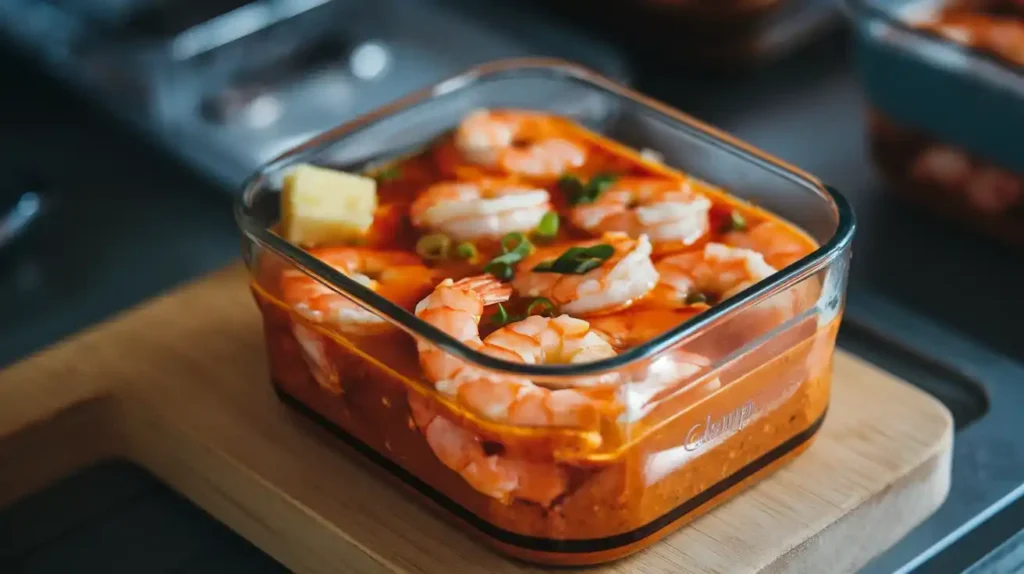
Leftover sweet and sour shrimp recipe can be a lifesaver for quick meals, but proper storage is essential to maintain its flavor and texture. Follow these steps:
- Cool Down Completely: Allow the shrimp and sauce to cool to room temperature before storing. This prevents condensation and preserves the dish’s quality.
- Use Airtight Containers: Transfer the shrimp and sauce into a sealed, airtight container to prevent moisture loss and keep the flavors fresh.
- Refrigeration: Store the leftovers in the refrigerator for up to 3 days. For longer storage, consider freezing.
Pro Tip: If you plan to freeze the dish, separate the shrimp and sauce into individual portions to make reheating easier and more convenient.
Reheating Without Losing Flavor or Texture
Reheating shrimp can be tricky as overcooking can make them rubbery. Here’s how to reheat leftovers effectively:
- Stovetop Method (Best for Maintaining Texture):
- Heat a small amount of oil or water in a skillet over medium-low heat.
- Add the leftover shrimp and sauce, stirring occasionally until warmed through. Avoid cooking for more than a few minutes.
- Microwave Method (Quick but Cautious):
- Place the shrimp and sauce in a microwave-safe dish, covered with a lid or damp paper towel to trap moisture.
- Heat in short intervals of 20–30 seconds, stirring in between, to prevent overcooking.
- Oven Method (For Larger Portions):
- Preheat your oven to 300°F (150°C).
- Place the leftovers in an oven-safe dish, cover with aluminum foil, and bake for 10–15 minutes until warmed through.
Avoid These Mistakes When Storing and Reheating
- Do Not Reheat Multiple Times: Only reheat the portion you plan to eat to preserve freshness.
- Don’t Overheat: Shrimp become tough and lose flavor when overcooked during reheating.
Tips and Tricks for Perfect sweet and sour shrimp recipe Every Time
Common Mistakes to Avoid When Cooking Shrimp
- Overcooking Shrimp: Shrimp cooks quickly, and even an extra minute on the heat can turn it rubbery. Remove shrimp from heat as soon as they turn pink and curl into a “C” shape.
- Skipping Preparation Steps: Neglecting to clean, devein, or dry shrimp can impact both texture and taste. Take the time to prep your shrimp properly for the best results.
- Using the Wrong Pan: A wok or non-stick skillet is ideal for stir-frying shrimp and evenly distributing heat. Avoid overcrowding the pan, as this lowers the temperature and leads to uneven cooking.
How to Add a Personal Twist to the Recipe
Customizing your sweet and sour shrimp recipe is a fun way to tailor it to your preferences. Here are a few ideas:
- Add Spice: Include red chili flakes, sriracha, or a dash of cayenne pepper for a spicier version.
- Experiment with Vegetables: Swap out bell peppers for zucchini, snap peas, or broccoli for different textures and flavors.
- Try Alternative Proteins: Substitute shrimp with chicken, tofu, or even a mix of seafood like scallops or calamari for variety.
- Incorporate Nuts: Add toasted cashews or peanuts for a delightful crunch that pairs well with the sauce.
Pro Tips for Restaurant-Quality Sweet and Sour Shrimp
- Velveting Shrimp: Toss shrimp in a mixture of baking soda and cornstarch before cooking to achieve that bouncy, tender texture seen in restaurant dishes.
- Layer Flavors: Sauté garlic and ginger before adding the sauce for an aromatic base.
- Serve Immediately: sweet and sour shrimp recipe tastes best fresh. Cook it just before serving to preserve its vibrant flavors and texture.
Final Presentation Ideas
- Garnish with sesame seeds and freshly chopped green onions for a visually appealing touch.
- Serve in a shallow dish with a side of steamed rice or noodles, creating a restaurant-style plating.

